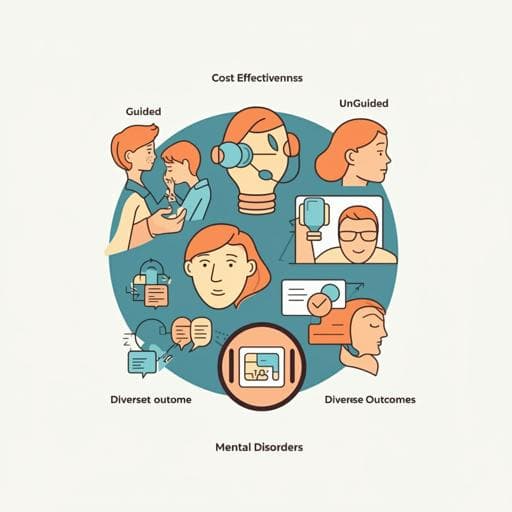
Medicine and Health
Systematic review of economic evaluations for internet- and mobile-based interventions for mental health problems
F. Kählke, C. Buntrock, et al.
This systematic review explores the cost-effectiveness of internet- and mobile-based interventions for mental disorders, revealing promising results, especially for guided therapies targeting depression and anxiety. Conducted by Fanny Kählke, Claudia Buntrock, Filip Smit, and David Daniel Ebert, it emphasizes the need for further investigation into unguided and preventive IMIs.
~3 min • Beginner • English
Introduction
Mental disorders are common and impose large health and economic burdens globally, including increased mortality, reduced quality of life, comorbidity with physical illnesses, and high direct and indirect costs. Despite effective psychological treatments, many individuals remain untreated due to attitudinal and structural barriers. Internet- and mobile-based interventions (IMIs) may mitigate these barriers by offering scalable, accessible, and effective care at potentially lower marginal costs. Prior reviews on IMI cost-effectiveness were limited, outdated, or methodologically heterogeneous (e.g., inclusion of partial economic evaluations or narrow focus on iCBT). This review asks whether IMIs for prevention and treatment of common mental disorders (MDs) represent good value for money and assesses their methodological quality to inform resource allocation decisions.
Literature Review
Previous systematic reviews of IMI cost-effectiveness included few studies, often used broad IMI definitions, sometimes reported costs and effects without relating them (partial evaluations), or focused narrowly on iCBT. Many are now obsolete (latest primary studies up to 2016). Evidence on economic value for standard treatments (psychotherapy, pharmacotherapy) is also limited, with some suggestion psychotherapy can be cost-effective. Therefore, an updated, comprehensive synthesis of full trial-based economic evaluations across MDs, guidance formats, and perspectives was needed.
Methodology
Design: Systematic review registered in PROSPERO (CRD42018093808) following PRISMA and economic evaluation review guidance. Databases: MEDLINE, PsycINFO, CENTRAL, PSYNDEX, and NHS Economic Evaluations Database; search through 05/10/2021 using terms for intervention/treatment/prevention, MDs, internet/online/mobile delivery, and economic evaluation.
Inclusion: RCTs with full economic evaluations (CEA, CUA, CBA, CMA) comparing costs and effects of IMIs versus comparators; populations with diagnosed MDs or validated symptom measures (e.g., MDD, anxiety disorders, PTSD, OCD, sleep disorders, suicidal ideation, psychological distress) of any age; online-delivered psychological interventions (CBT and other evidence-based approaches), guided or unguided; comparators included other psychological interventions, TAU, waitlist control (WLC), or attention control (AC); peer-reviewed, English or German.
Exclusion: Non-online/blended with therapist F2F/video, partial economic outcomes (no costs linked to effects), modeling studies, non-RCTs, protocols, abstracts, non–peer-reviewed, cost-of-illness, observational, cohort, case, pilot/feasibility studies.
Study selection and extraction: Dual independent screening and full-text assessment (F.K., C.B.) with arbitration (D.D.E.); interrater agreement κ=0.90–0.91. Data extracted per CHEERS: participant/study characteristics, intervention details, economic outcomes, type of evaluation, cost characteristics (categories, sources, price year, currency, incremental costs), perspective, and cost-effectiveness estimates (incremental costs/effects, ICER/ICUR, CEACs).
Outcomes and thresholds: Cost-effectiveness adjudicated as dominance (more effective, less costly) or cost per QALY below £30,000 (NICE). For disease-specific CEAs, considered cost-effective when probability at WTP £0 ≥80%. Costs converted to 2020 Pound Sterling via GDP inflators and PPP.
Quality appraisal: Methodological quality via CHEC (20-item checklist; scored as %; categories: excellent 95–100%, good 75–94%, average 50–74%, poor <50%). Risk of bias via Cochrane tool (selection, detection, attrition, reporting, other biases; converted to AHRQ quality ratings).
Key Findings
- Corpus: 36 economic evaluations from 32 RCTs (10,083 participants), published 2010–2021; countries: Australia (2), Canada (1), Germany (7), Netherlands (8), UK (6), Spain (1), Sweden (10). Populations: mostly adults; some adolescents and >65 years. Targets: depression/MDD (15), anxiety disorders (7), OCD (4), insomnia (2), stress-related/elevated stress (2), PTSD (1), suicidal ideation (1). Most interventions were iCBT; some iPST, mixed (IMA), iPPI, iPCT. Guided IMIs (n≈21–24) predominated; unguided (≈9–11); a few compared both.
- Perspectives and horizons: Societal (15 solely; 9 both societal/healthcare), healthcare (6 solely), employer (3). Follow-up horizons ranged ≤3 months (12), >3–≤6 months (8), >6–≤12 months (9), and 2–4 years (4).
- Overall economic results: In about half of CEAs (14 of 31), IMIs were dominant (more effect, lower cost). Many CUAs (26 of ~30) were below £30,000/QALY; 13 were dominant. Using ≥80% probability at £30,000/QALY when reported, 11 IMIs judged cost-effective. Employer-perspective CBAs (3) showed BCR >1 (1.6–3.1) and positive net benefits (181–417).
- Depression/MDD: Guided IMIs vs WLC generally cost-effective (<£30,000/QALY; probabilities ~55–98%). Guided vs TAU showed mixed results by perspective/time. Guided vs unguided: one NHS-perspective study favored guided (more QALYs at lower costs). Unguided IMIs showed limited or unclear cost-effectiveness vs TAU/WLC/AC; one study showed acceptable likelihood from societal perspective. Prevention/relapse IMIs: moderate to acceptable probabilities of cost-effectiveness (CUA ~40–64%).
- Anxiety disorders: Guided IMIs vs WLC/AC showed high probabilities of cost-effectiveness (>90% <£30,000/QALY) and often dominance at WTP £0. Guided IMIs vs group CBT (gCBT) were cost-effective short- and long-term from societal and healthcare perspectives, though long-term CEA probability decreased. Unguided IMIs had mixed/limited support; one PTSD self-help app vs TAU had low probability of cost-effectiveness (27% at £30,000/QALY).
- OCD: Mixed evidence. iCBT vs AC cost-effective for QALYs (90–95% at £30,000) but not for short-term clinical remission; booster program not cost-effective for preventing relapse over 2 years; other trials vs WLC/self-help provided inconsistent or insufficient economic probabilities.
- Insomnia and stress-related conditions: IMIs often cost-effective per QALY and sometimes dominant for clinical outcomes. For insomnia, IMIs vs WLC showed very high CUA probability (up to 99%); CEAs varied by perspective (e.g., societal/employer favorable, healthcare sometimes unfavorable). Adolescent insomnia: IMI vs group CBT had high probability of cost-saving at WTP £0 and greater QALYs (CUA not reported). Stress/adjustment/exhaustion: CUAs below threshold (75–79% probabilities); CEAs often dominant from societal/employer but not healthcare perspectives.
- Workplace setting: Guided IMIs for insomnia, stress, and depression yielded favorable CBAs (BCR 1.6–3.1; positive net benefits), indicating employer value.
- Quality: CHEC average 85% (range 56–100%); 3 excellent, 3 average. Common shortcomings: limited generalizability discussion (n=29), short time horizons (n=16), limited sensitivity analyses (n=8). RoB mostly good (n=22), with some reporting and other biases noted.
- Heterogeneity: High across costing methods, perspectives, comparators, outcomes, and time horizons, limiting cross-study comparability.
Discussion
The review addressed whether IMIs provide good value for money across mental health conditions by synthesizing trial-based full economic evaluations. Findings indicate guided IMIs, particularly iCBT, generally offer cost-effective treatment options for depression and anxiety, often achieving QALY gains below accepted thresholds and, in many CEAs, dominance over control conditions. Evidence extends to under-researched areas (insomnia, stress), where IMIs frequently achieved favorable cost-utility and, in employer settings, positive cost-benefit results. However, unguided IMIs showed limited and inconsistent cost-effectiveness, and evidence for OCD and PTSD was mixed, reflecting heterogeneity in comparators and outcomes. These results support integrating guided IMIs into care pathways (e.g., low-intensity or stepped-care models), with consideration of perspective (societal, healthcare, employer) influencing value judgments. Despite promising trends, substantial methodological and design heterogeneity constrains definitive conclusions and generalizability beyond high-income Western settings.
Conclusion
Guided internet-based CBT for anxiety disorders and major depressive disorder shows a high probability of being cost-effective, often dominating usual care or passive controls and meeting QALY thresholds. IMIs for insomnia, suicidal ideation, and stress also demonstrate potential cost-effectiveness, whereas evidence for OCD is less firm and unguided interventions remain uncertain. The review provides contemporary, quality-appraised evidence to inform healthcare and employer decision-making. Future research should focus on: unguided and preventive IMIs with active comparators; broader disorder coverage (including under-represented anxiety subtypes and specific phobias); studies in low- and middle-income countries; longer time horizons; carefully chosen evaluation perspectives; adherence to economic reporting guidelines (ISPOR, CHEERS) and quality checklists (Drummond, CHEC); and investigation of acceptability and implementation factors.
Limitations
- High heterogeneity across studies (designs, populations, comparators, perspectives, costing methods, outcomes, time horizons) limits comparability and synthesis.
- Incomplete or inconsistent inclusion of development/maintenance and intervention costs may underestimate true intervention costs; many studies did not fully report intervention costs or only valued therapist time.
- WTP thresholds: Diagnosis-specific CE outcomes lack established WTP thresholds; the £30,000/QALY threshold is somewhat arbitrary and varies by country, complicating interpretation and adoption.
- Most trial-based economic evaluations are underpowered for cost and QALY differences, yielding wide uncertainty around ICERs.
- Short follow-up periods in many trials; some annualized short-term data, adding uncertainty.
- In several studies, CE planes/acceptability curves were not reported, limiting uncertainty appraisal.
- Limited generalizability beyond high-income Western settings; language restriction (English/German) may introduce selection bias.
Related Publications
Explore these studies to deepen your understanding of the subject.







